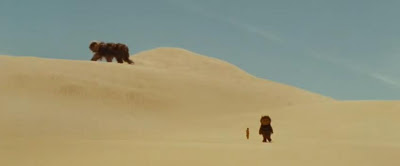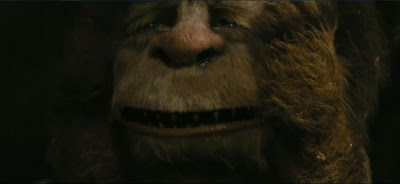“I’m expecting your review of Where the Wild Things Are in my inbox by noon tomorrow.”
That was my buddy Brian two days ago, and while he wasn’t offering me a salaried position at a major newspaper in exchange for my commentary, I was nevertheless pleased to learn – as I always am – that someone wanted to know my particular opinion of a film. But he wasn’t the only one. A number of people I know have expressed enthusiasm about Spike Jonze’s adaptation of Maurice Sendak’s beloved book, including those who are rarely enthused about movies.
(For the record, I don’t really remember Sendak’s book. I certainly remember reading it several hundred times, but I don’t recall the impression it made on me as a boy. Some books latch onto my memory – the Hardy Boys, Where the Red Fern Grows, the 1990 NFL Record and Fact Book – and never relinquish their hold, but “Where the Wild Things Are” just wasn’t one of them. Fortunately, I’m discussing the movie, not the book.)
The question, of course, is whether the enigmatic Jonze – making just his third feature in 10 years – can deliver a movie that charms mature audiences the way Sendak’s book seduced multiple generations of pre-schoolers and their parents. And the answer, strangely enough, hinges mostly on perspective. Essentially, what you get out of Where the Wild Things Are depends entirely on what you put into it. If you’re willing to interpret its formless narrative as a delicate allegory, you’ll likely construe it as a graceful, enchanting meditation on the majesty of childhood and the universality of the family. If you’re less inclined to burrow into its ethereal, dreamy illogic, you’re bound to be frustrated by its flimsy characters and loose, half-baked plot.
For my part, I came away from Where the Wild Things Are more impressed than enchanted. It’s a beautifully constructed film that has minimal desire to make any actual sense. I’ll refrain from providing a plot summary, not because I want to avoid spoilers, but because there’s hardly a plot to summarize. Very little happens, and what does take place transpires according to the movie’s own internal, incomprehensible set of rules. Characters cheer and cry and tumble and roar, but we’re unable to discern the reasons behind either their actions or their emotions. Perhaps Jonze and fellow screenwriter Dave Eggers understand their characters’ underlying motivations, but they seem perfectly content to keep us on the outside looking in.
The counter to this, of course, is that this is a children’s story, or more precisely, a story springing from the mind of a child. It isn’t supposed to make sense. It’s supposed to arise from the depths of a child’s imagination, and children imagine half-formed worlds where gigantic furry beasts build huge forts and cut holes in trees and converse with mechanical owls. Imposing the burden of logic would necessarily dampen the magic.
And that’s fine. But the recesses of the mind are a murky place, and they can be awfully confusing without a guide. Jonze’s stubborn insistence on refusing to shepherd his audience may be in keeping with his artistic vision – that a child’s fantasy world can be plagued by the same problems as his real one – but that stubbornness blunts the emotional impact of his themes. His two prior films (the fascinating Being John Malkovich and the irreverent Adaptation.) were fantastical adventures that were nevertheless grounded in reality, giving real-world heft to their characters’ bizarre dilemmas. Where the Wild Things Are, in contrast, is so thoroughly immersed in its own self-invented universe that it fails to fully engage.
That universe, however, is quite a place. The movie is a technical marvel; if nothing else, Jonze has proven himself a master craftsman in the mold of Tim Burton. He shows us a world of heavily wooded forests, vast deserts, towering cliffs, and infinite oceans, all of which seem to have been invented on the spot – the effortless bounty of a child’s dreams. The dwellings that the characters construct have a zany, ramshackle feel that imbues them with a sense of the mystical, while the soundtrack by Karen O (of Yeah Yeah Yeahs fame) slides gracefully between the sadness of alienation and the free-wheeling joy of youth.

And of course there are the wild things themselves. Their physical appearance defies ordinary description: They seem to possess normal-sized legs and feet, only with enormous, round, fur-covered bodies and heads, like colossal brown snowmen. The bodies are impressive for the limber quality of their movements – kudos to the F/X crew for effortlessly disguising their technique – but it’s the faces that truly astonish. With their long, flat mouths and deep-pooled eyes, the creatures can convey thoughts without speaking. We may not understand why they express certain emotions, but they are able to express them. These beasts may be gigantic and furry, but they cry real tears.

If only we had a deeper understanding of the reasons behind those tears, then perhaps the movie’s thesis could match the power of its images. Still, despite its steadfast refusal to allow logic to intrude on its reverie, Where the Wild Things Are remains at least legitimately interesting and occasionally compelling. I also have to commend it for encouraging contemplation and for not pandering to audiences with rote action sequences or stock melodrama. And it’s difficult to judge too harshly a film that seems so serenely comfortable with itself. I just can’t help the feeling that I want more. But then, perhaps I’m acting like a child.
Jeremy Beck is the editor-in-chief of MovieManifesto. He watches more movies and television than he probably should.

I felt like I was never really able to let go and enjoy the craziness… maybe that was due to my attitude, but I was pumped to see it and ready to have some fun… I do believe it is worth seeing though, I did enjoy it
Yeah, you were definitely set up for disappointment if you were expecting a rollicking time.
Apparently some parents are upset because the movie was "too sad", but I'll side with Jonze on that. I hate the attitude that movies about children need to be happy and inoffensive. The whole point of the movie is that kids are prone to dark feelings and sadness as well as random bouts of zany wildness. Even if the movie wasn't all that enjoyable, kudos to Jonze for not giving in to mainstream pressure.